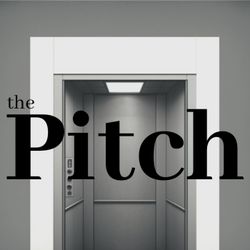Latest episode

5. Unlocking the Potential of Carbon Markets Through Transparency (with Saif Bhatti, Founder & CEO of Renoster)
38:28||Season 2, Ep. 5In this episode of the Pitch, I spoke with Saif Bhatti from Renoster about their innovative approach to the carbon market. Saif outlined Renoster's mission to revolutionize carbon credit transparency and understanding, a leap from their initial focus on anti-poaching. We explored how they employ advanced techniques like remote sensing and AI to assess carbon sequestration projects accurately, emphasizing their commitment to transparency. This is crucial in a market fraught with challenges like misrated carbon credits and regulatory uncertainties. Saif shared insights into Renoster's unique business model and their role in shaping the integrity of the carbon credit market. It was enlightening to understand Renoster's impact in driving substantial climate action through market transparency.Find out more at renoster.coCheck out Saif on LinkedIn https://www.linkedin.com/in/saifbhatti/Questions from the PodHow would you pitch Renoster in a couple of sentences?What was the aha moment (Came up with the idea)?What’s the problem you are trying to solve? Why now?What’s your solution? How would you describe your product? How would you answer people saying I don’t trust ratings?Who is your target customer? What’s your business model? How big is the market and how fast is growing? How do you measure traction? What number proves you are on the right track?Who are your main competitors? And how do you think you can build a long lasting competitive advantage? USPWhat is the existing solution?How is your team? What makes your team perfect for the job?What are the major risks you see ahead?Have you already raised? Are you looking to raise soon?Your take on the latest New Yorker piece
More episodes
View all episodes

4. the Pitch: Stenver Jerkku Founder and CEO of Solid World | Building the NASDAQ of carbon markets | Current carbon markets are opaque and illiquid | How to mitigate delivery risk | Restoring Mangroves
32:10||Season 2, Ep. 4In this episode of the Pitch, I spoke with Stenver Jerkku about how his company Solid World is working to improve liquidity and transparency in the forward carbon credit market. We discussed how Solid World is creating tokenized prepaid carbon credit pools that allow project developers to sell carbon credits upfront in order to obtain funding. This aims to streamline a process that currently lacks visibility and liquidity. Stenver explained that key metrics like total value locked in the pools and trading volumes have been increasing since launch. While delivery risk remains, Solid World's rigorous vetting process provides projects access to a standardized sales channel. It was fascinating to learn more about the innovative solutions Solid World is bringing to scale high-quality climate action globally.Timestamps00:27 - The elevator pitch05:13 - The problem09:56 - The Solution13:53 - Target customers and benefits of working with Solid World20:57 - Stenver's views on growth in the carbon markets23:25 - Key metrics and traction Solid World is seeing so far26:47 - Comparing Solid World to other solutions and competitors29:45 - Major risks and challenges for going forwardDiscover more about Solid World: https://www.solid.world/
3. the Pitch: Nura Linggih co-founder of Pleno | Bringing credibility to carbon projects | How to use tech to verify projects faster | Mangroves and the future of the VCM
34:43||Season 2, Ep. 3Nura is building Plano to simplify the carbon credit creation process, which is currently complex, time-consuming and expensive for projects. Their vision is to digitize the process using machine learning and blockchain.Plano's initial focus is on "blue carbon" mangrove projects in Indonesia, where they are piloting their rapid assessment tool. Their goal is to eventually support all nature-based carbon projects globally.Early traction includes over 40 projects on their early access waiting list and partnerships with 3 pilot projects plus 5 more in the pipeline for testing.While competitors exist like Revalue Nature, Plano aims to truly streamline the end-to-end process and make it accessible to anyone wanting to set up a carbon project.The voluntary carbon markets targeting natural solutions like mangroves are still small but growing rapidly as more organizations set climate targets.Despite criticisms, Nura believes nature-based credits will continue playing a key role given the many environmental and social co-benefits they provide over engineering solutions alone.0:00-2:00 - Introduction to Nura's founder and experience that led him to identify problems with current carbon credit validation process.2:00-5:00 - Further background on complex multi-step process today and Nura’s vision to digitize, streamline and automate validation of carbon projects on their SaaS platform Plano.5:30-8:00 - In-depth explanation of specific pain points Plano aims to solve 8:00-10:30 - How they plan to rapidly assess carbon reductions and generate credits using computer vision, remote sensing and machine learning algorithms11:00-13:30 - Deep dive on mangrove pilot projects underway in Indonesia, partner details and early lessons from digital assessments.13:30-16:00 - Challenges assessing mangrove systems and adaptations made to validation tools and methodology.16:00-18:30 - Partnerships in 5 other countries and pipeline of additional projects interested in using Plano.18:30-21:00 - Traction to date including 40+ projects on waitlist and differentiation from other vendors.21:00-23:30 - Outlook for voluntary carbon markets growth and future of compliance markets.23:30-26:00 - Funding landscape, current fundraising round details and target milestones.26:00-End - Product roadmap, priority features and customer onboarding plans.
2. the Pitch: Grégoire Guirauden co-founder of Riverse | Helping circular economy solutions monetising their impact | The credibility of carbon credits and greenwashing | The main competitor is inaction
33:50||Season 2, Ep. 2Grégoire talks about Riverse a carbon credit standard and platform enabling green tech projects in Europe to measure, verify and monetize their environmental impacts. Riverse is solving the major problem of lack of funding for the low-carbon transition, estimated at hundreds of billions annually needed.Through developing a new carbon credit methodology and digital MRV platform, Riverse provides an efficient way for circular economy and decarbonization projects to participate in the voluntary carbon market. Their customers include European green tech developers and large corporate carbon credit buyers.Riverse has seen traction with over 50 customers and verification of 28,000 tons of reductions so far. A key challenge discussed was building trust in a new methodology, which Riverse is addressing through steps like third-party validation and transparency.In the future the want to scale the team and the amount of projects verified. To close we discussed of major risks like the state of the carbon market.
1. the Pitch: Carbon Removal Revolution | How NeoCarbon Plans to Make Direct Air Capture More Accessible, Scalable and Affordable with René Haas, Co-Founder & CEO
35:57||Season 2, Ep. 1In this episode of the Pitch, we speak with René Haas, Co-Founder and CEO of Neocarbon, about the company's mission to remove CO2 from the atmosphere in an efficient and cost-effective manner. René discusses how Neocarbon's innovative approach of leveraging existing waste heat and airflow infrastructure at industrial sites can help scale up direct air capture technology and bring down costs significantly.We learn about Neocarbon's unique technology, early pilots, target customers and go-to-market strategy. René also shares his perspective on the challenges and opportunities in the carbon removal market, future risks and competition. Overall, it's an insightful discussion on Neocarbon's work to make an important climate solution more viable and accelerate progress towards decarbonization goals.The resources he mentionedCarbon Dioxide Capture and Storage or chat with it hereNo One Is Too Small to Make a Difference by Greta ThunbergHow to Avoid a Climate Disaster by Bill Gates
7. Miha Jagodic CEO and Co-Founder of Bloq.it | 90% of the cost resides in the last mile | Grew 10x 3 years in a row | Agnostic parcel lockers
31:26||Season 1, Ep. 7I met Miha 3 years ago, he was already building Bloq.it and could feel his passion. What they have achieved revolutionising the last mile delivery is nothing short of extraordinary. In this episode you will hear how Bloq.it was built, the current extraordinary performance and much more! To kick us off coils you give us an elevator pitch?What was the aha moment (Came up with the idea)?What’s the problem you are trying to solve? Why now?What’s your solution? How would you describe your product? Who is your target customer? Who are your early adopters? How many clients do you have already? What’s your go to market strategy?What’s your business model? Who pays?How big is the market and how fast is growing? How do you measure traction? What number proves you are on the right track?Who are your main competitors? And how do you think you can build a long lasting competitive advantage? What was the existing solution before?USPCost?How is your team? What makes your team perfect for the job?What are the major risks you see ahead?Have you already raised? Are you looking to raise soon?The company: Bloq.itThe founder: Miha Jadogic
6. Nick Stodt Co-Founder of peopleIx | Loosing tech talent can cost more than 160k | Most decisions in HR are still based on gut feeling | HR tech is needed especially in this market
32:52||Season 1, Ep. 6Nick studied Finance at Nova SBE In Lisbon. After working in venture capital and at a B2B ML startup, he and his Co-Founder Georg realized what impact great people management and strategy have on the success of any organization. So they founded peopleIX to enable data-driven people decision making for modern organizations.Can you give me an elevator pitch of what is PeopleIX?What was the aha moment (Came up with the idea)?What’s the problem you are trying to solve? Why now (In a moment of cost cutting)?What’s your solution? How would you describe your product? Is it a full product or just a feature?Who is your target customer? What’s your go to market strategy?Which type of companies do you think will your early adopter?What’s your business model? How big is the market and how fast is growing?How do you size the market? How do you measure traction? What number proves you are on the right track?Who are your main competitors? And how do you think you can build a long lasting competitive advantage? What was the existing solution?Why are you the right people to build this?What are the major risks you see ahead (Pre mortem)?Have you already raised? Are you looking to raise soon?What would you tell recent grads on how to pick between working for a startup or consulting/IB?
